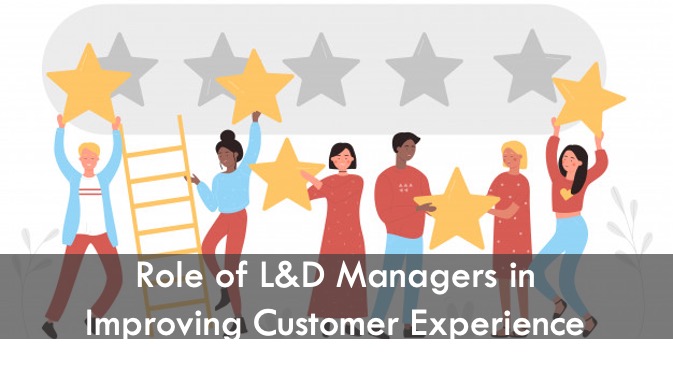Me to an L&D leader: “Do you deal with customer-centric training?” The reply: “Well, I am a learning and development professional. Do I really need to be concerned with customer experience issues?” After hearing the response, I was a bit surprised, honestly! Improving customer experience is vital for the growth of any business. L&D teams should collaborate with client-facing departments, such as marketing and sales, to develop targeted training materials. Why? To answer this query, let’s first understand the exact meaning of customer experience.
Table of Contents
What do You Mean by Customer Experience?

As the name suggests, customer experience is the total of all your interactions your customer has with your company. Following the interactions, a buyer needs to feel satisfied. S/he should believe that the entire end-to-end journey with your brand was enriching. Customer experience begins before a buyer seeks your services/products and ends after s/he leaves your organization.
How is Customer Service Linked With Teams Which Are Not Client-Facing?
Let’s answer this question by taking the example of the L&D team. Maybe your leadership is not clear about the exact customer experience your brand needs to deliver. Then, how will they develop the required corporate online learning materials — that align with your end goals? Learning corporate should never be focused only on internal functions like processes and systems. If this is the case, your workforce will perceive their role as task-based rather than experience-based.
E-learning corporate training delivers the best results when employees understand how their performance will help in improving customer experience. Your learning management system‘s content could serve as the bridge between a comfortable, convenient experience and a painful, frustrating one. Even other teams, such as accounting, can feel that they have no role in dealing with buyers and improving customer experience. However, since the company’s offerings are directly related to the target audience, each department holds responsibility for improving customer experience.
Research suggests that “experience-driven businesses have a greater average year-on-year increase than other brands, 2.2 times more.” And numbers don’t lie. Therefore, you must improve customer experience throughout the enterprise, not just in traditionally customer-facing roles.
So, How Can the L&D Leadership Help Create a Customer-centric Organisation?

To promote a corporate learning culture that ensures a customer-centric organization, learning should incorporate CX ideas. It should include actual data, skillsets, and results — for teams not directly connected to customer-facing roles. Instead of delivering training only to your contact center agents, think of customer experience learning sessions for other departments. Related teams include sales, accounting, and marketing, among others. It would be great if everyone in your organization clearly understand their specific role with the customer. Let us now see how L&D teams, in particular, can improve customer experience.
Read More: Building a Culture of Learning!
Analyse How Your Teams’ Regular Tasks Are Related to Improving Customer Experience
Allow me to explain this with the help of an example. Suppose you are developing the best LMS software for internal tech support. How is this department related to customer experience? This specific department is concerned with fixing only company-wide technological glitches. Therefore, they may be called in by sales and customer support teams only when there is a last-minute problem.
Ad: PlayAblo’s Enterprise-Grade Micro-Learning platform is for the modern corporate learner. Micro-Learning, along with assessments and gamification features, ensures learning outcome measurement along with sustained engagement.
Find out more and request a custom demo!
Maybe a customer is waiting for a particular service, and there is a huge issue. Therefore, even tech support plays an important part in responding to customers in times of crisis. Their primary tasks are keeping technology updated and responding to challenges internally. Once you incorporate these elements into your corporate learning management schedule, you can ensure a seamless customer experience.
Read More: eLearning Can Reduce Your Customer Training Costs
As an L&D leader, you must be able to connect the dots regularly. For instance, your accounting team must know how correct invoices and timely payments are critical in protecting vital partnerships and vendor relationships. In turn, your partners will be able to serve the customer. Additionally, you must train your teams to respond to queries and answer emails from skeptical partners. All of the above measures help your suppliers to keep up with your brand’s promises.
Consider Customer Experience to be a Complete Business Discipline
Customer experience is a discipline that has real outcomes and measurements. It affects your entire organization when the profits drop or when there is a spike in your revenues. Of course, without sales and revenue, there is no business. Therefore, you can have the same metrics for satisfied customers as well. Explain the critical CX numbers in your company to everyone. For instance, ensure that the loading dock crew is aware of NPS and its measuring methods. Communicate the figures to your entire workforce and create awareness. Include these elements in your training sessions and conduct online modules for each department.
Create a Full-fledged Communication Channel About CX
Leaders usually conduct campaigns to improve customer experience. Your enterprise LMS modules may contain an article about the same, or you might mention this topic in a meeting. However, such communications should form a part of your corporate learning curriculum. CX MUST not only be about promises, but it SHOULD explain how to live up to those promises.
CX should be an integral part of your communication channels, which are woven into your eLearning best practices. The sessions should outline how CX will impact your customers. Will a new process imply less or more effort on the customers’ part? Ask these questions and prepare detailed answers. As an L&D leader, you should create a culture where the employees are ready to work toward enhancing the overall customer experience. And PlayAblo‘s LMS has proven to lower your customer acquisition costs!
Conclusion
Your strategy toward improving customer experience will be fruitful only when your teams are focused and ready to act and deliver the related end goals. This need for focus and commitment to action applies to the whole organization. L&D leaders require to clearly define the vision of customer experience, which your brand aims to deliver. Bring everyone on board with this cohesive vision. And you are all set! Or you can seek the guidance of PlayAblo‘s experts and we will be glad to help you out!
Ad: PlayAblo’s Enterprise-Grade Micro-Learning platform is for the modern corporate learner. Micro-Learning, along with assessments and gamification features, ensures learning outcome measurement along with sustained engagement.
Find out more and request a custom demo!







2 Comments
Comments are closed, but trackbacks and pingbacks are open.